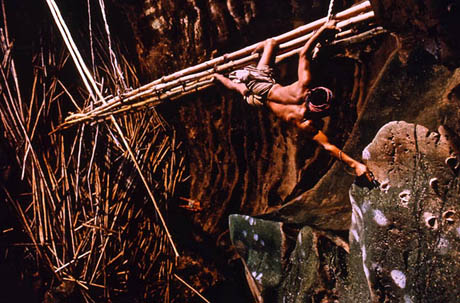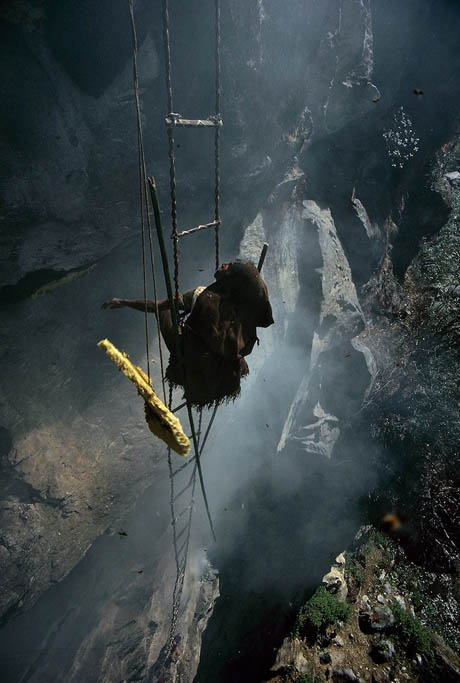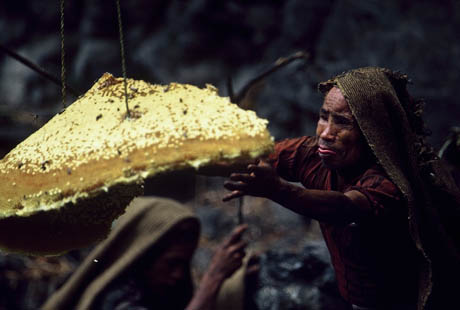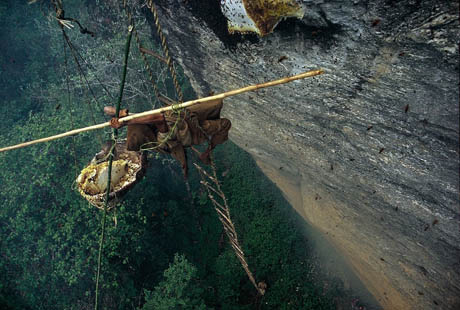A new post on BLDGBLOG shows Eric Valli’s incredible photographs of men hunting for edible bird’s nests in the caves of Thailand, using a terrifyingly flimsy-looking assemblage of bamboo trellises, rattan ladders, and industrial nylon rope.

IMAGE: From the series “Shadow Hunters,” by Eric Valli.
In passing, the post mentions some of Valli’s other work, including a photo story documenting the “vertiginous and mind-bending world of ‘honey hunters‘ in the Himalayas.” This series, first published in National Geographic in 1988, won the World Press Photo Award for Nature Stories that year and remains awe-inspiring today.
In the shots, we see elderly Gurung tribesmen descending rope ladders hung over cliff faces in the Himalayan foothills, carrying long bamboo poles both for balance and to dislodge the hives, which are then lowered to the ground using a pulley system. The Himalayan honey bee, Apis dorsata laboriosa, is the world’s largest, and its nests, which are only found at altitudes between 2,500 and 3,000 metres, can apparently contain as much as 60 kilograms of honey.

IMAGE: From the series “Honey Hunters of Nepal,” by Eric Valli.
The harvest is carried out twice a year, with the spring, or “red,” honey being especially valuable for its medicinal qualities, which are derived from grayanotoxin, a chemical produced by the rhododendrons on whose nectar the bees dine. But, according to another National Geographic article on the Himalayan honey bee, this one from 2004, red honey’s “relaxing properties” are currently threatening the bee’s very survival.

IMAGE: From the series “Honey Hunters of Nepal,” by Eric Valli.
Highly sought after by middle-aged men as a sexual performance enhancer, the red honey (also known as “mad honey”) reportedly fetched as much as $15 per kilo in 2004, which inspired the Nepali government to transfer “ownership of the cliffs from indigenous communities to the government and open up honey harvesting rights to contractors on a first-come, first-served basis,” according to Farooq Ahmad, coordinator of the Himalayan Honeybees project for the International Center for Integrated Mountain Development (ICIMOD) in Kathmandu, Nepal.
As a result, traditional honey hunting techniques and rituals that ensured a sustainable harvest and maintained bee populations have given way to non-traditional techniques that denude cliffs of nests in an effort by contractors to maximize profits.

IMAGE: From the series “Honey Hunters of Nepal,” by Eric Valli.
Nonetheless, Ahmad is hopeful that honey hunting eco-tourism can help save the bees, which, according to National Geographic, are the prime pollinator for the entire Himalyan region, by rewarding the use of traditional, sustainable techniques with overseas dollars, and thus inspiring both a government policy reversal and an influx of young Gurung apprentices that will help keep the Himalayan honey hunters’ particular skills and knowledge alive.
For more of Valli’s photographs of extreme hunting infrastructure, visit his website, as well as BLDGBLOG’s post on the subject.
2 Comments
I saw large nests, under cliff overhangs in the mid Langtang Valley twelve or so years ago. How did they fare with the earthquakes?
Wow, amazing photos n subject of interest!!